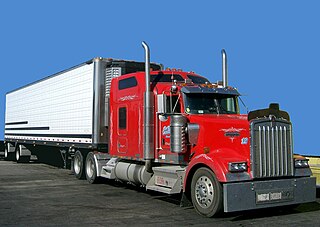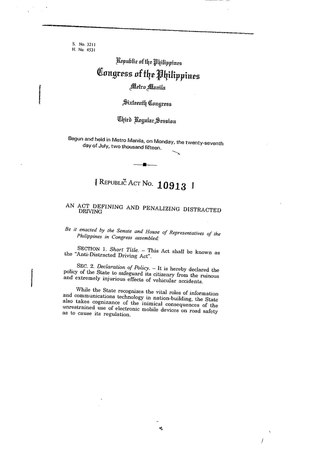Related Research Articles

An L-plate is a square plate bearing a sans-serif letter L, for learner, which must be affixed to the front and/or back of a vehicle in many countries if its driver is a learner under instruction, or a motorcycle rider with provisional entitlement to ride restricted motorcycles.

A commercial driver's license (CDL) is a driver's license required in the United States to operate large and heavy vehicles or a vehicle of any size that transports hazardous materials or more than 15 passengers.
Graduated driver licensing systems (GDLS) are designed to provide new drivers of motor vehicles with driving experience and skills gradually over time in low-risk environments. There are typically three steps or stages through which new drivers pass. They begin by acquiring a learner's permit, progress to a restricted, probationary or provisional license, followed by receipt of a full driver's license. Graduated drivers' licensing generally restricts nighttime, expressway, and unsupervised driving during initial stages, but lifts these restrictions with time and further testing of the individual, eventually concluding with the individual attaining a full driver's license.
A driver's permit, learner's permit, learner's license or provisional license is a restricted license that is given to a person who is learning to drive, but has not yet satisfied the prerequisite to obtain a driver's license. Having a learner's permit for a certain length of time is usually one of the requirements for applying for a full driver's license. To get a learner's permit, one must typically pass a written permit test, take a basic competency test in the vehicle, or both.

An International Driving Permit (IDP), often referred to as an international driving license, is a translation of a domestic driving license that allows the holder to drive a private motor vehicle in any country or jurisdiction that recognises the document. The term International Driving Permit was first mentioned in the document prescribed in the International Convention relative to Motor Traffic that was signed at Paris in 1926, and is a translation of the French 'permis de conduire international', or 'international driving license'. The Paris treaty, and all subsequent, use the word 'permit' exclusively in relation to all kinds of driving license.

The Land Transportation Office is an agency of the Philippine government under the Department of Transportation responsible for all land transportation in the Philippines. Functions of the LTO include the inspection and registration of motor vehicles, issuance of licenses and permits, enforcement of land transportation rules and regulations, and adjudication of traffic cases.

Driver licences in Australia refer to the official permit required for a person to legally drive a motor vehicle in Australia. The issue of driver licences, alongside the regulation and enforcement of road use, are all managed by state and territory governments.

In the United States, driver's licenses are issued by each individual state, territory, and the District of Columbia. Drivers are normally required to obtain a license from their state of residence. All states of the United States and provinces and territories of Canada recognize each other's licenses for non-resident age requirements. There are also licenses for motorcycle use. Generally, a minimum age of 15 is required to apply for a non-commercial driver license, and 25 for commercial licenses which drivers must have to operate vehicles that are too heavy for a non-commercial licensed driver or vehicles with at least 16 passengers or containing hazardous materials that require placards. A state may also suspend an individual's driving privilege within its borders for traffic violations. Many states share a common system of license classes, with some exceptions, e.g. commercial license classes are standardized by federal regulation at 49 CFR 383. Many driving permits and ID cards display small digits next to each data field. This is required by the American Association of Motor Vehicle Administrators' design standard and has been adopted by many US states. The AAMVA provides a standard for the design of driving permits and identification cards issued by its member jurisdictions, which include all 50 US states, the District of Columbia, and Canadian territories and provinces. The newest card design standard released is the 2020 AAMVA DL/ID Card Design Standard (CDS). The AAMVA standard generally follows part 1 and part 2 of ISO/IEC 18013-1. The ISO standard in turn specifies requirements for a card that is aligned with the UN Conventions on Road Traffic, namely the Geneva Convention on Road Traffic and the Vienna Convention on Road Traffic.
In Canada, driver's licences are issued by the government of the province or territory in which the driver is residing. Thus, specific regulations relating to driver's licences vary province to province, though overall they are quite similar. All provinces have provisions allowing non-residents to use licences issued by other provinces and territories, out-of-country licences, and International Driving Permits. Many provinces also allow non-residents to use regular licences issued by other nations and countries. Canadian driver's licences are also valid in many other countries due to various international agreements and treaties.
In Pakistan, the driving licence is the official document which authorises its holder to operate various types of motor vehicles on publicly accessible roads. Driving licences can be obtained by submitting an application to any licensing authority in the applicant's district.
A driving licence in Singapore is required before a person is allowed to drive a motor vehicle of any description on a road in the country. Like many other countries in the world, an individual must possess a valid driving licence before being permitted to drive on the road, and driving licence holders are subject to all traffic rules.
A driving licence is a document that allows the holder to drive on any roads in the Republic of China. It is issued by the Ministry of Transportation and Communications to a qualified motor vehicle driver. The number on a license is the same as the ID number of the license holder's household registration in Taiwan. In Taiwan, the license is sometimes accepted as a valid identity document, as its information replicates most of what is on a National Identification Card.
The New Zealand driver licence system is a graduated system that has been in place since 1988. It consists of three phases for a car licence, each with varying levels of conditions.

In the United Kingdom, a driving licence is the official document which authorises its holder to operate motor vehicles on highways and other public roads. It is administered in England, Scotland and Wales by the Driver and Vehicle Licensing Agency (DVLA) and in Northern Ireland by the Driver & Vehicle Agency (DVA). A driving licence is required in England, Scotland, and Wales for any person driving a vehicle on any highway or other "road", as defined in s.192 Road Traffic Act 1988, irrespective of the ownership of the land over which the road passes. Similar requirements apply in Northern Ireland under the Road Traffic Order 1981.

A driving licence is required in Malaysia before a person is allowed to drive a motor vehicle of any description on a road in Malaysia under Section 26(1) of the Road Transport Act 1987. Under section 26(1) of the Road Transport Act, an individual must possess a valid driving licence before being permitted to drive on the road, or can be prosecuted under section 26(2). Upon conviction, the miscreant is liable to fines or jail or both. Driving licence holders are subject to all traffic rules stated in the Road Transport Act 1987.

The Indonesian driving license is a legal document required for a person to be allowed to drive a motor vehicle in Indonesia. It is issued by the Indonesian National Police (POLRI), renewable every 5 years, and is valid in all ASEAN member states without an International Driving Permit. Driving license holders are subject to all Indonesian road rules and regulations. There is no provisional driving license in Indonesia.

Driving licence in Thailand is a document that allows the holder to drive on any roads in the Kingdom of Thailand. The minimum age to drive a motor vehicle is 18, and to drive a motorcycle is 15. Driving licence is issued and administered by the Department of Land Transport, Ministry of Transport and its branches, land transport offices across Thailand.

A driver's license, driving licence, or driving permit is a legal authorization, or the official document confirming such an authorization, for a specific individual to operate one or more types of motorized vehicles—such as motorcycles, cars, trucks, or buses—on a public road. Such licenses are often plastic and the size of a credit card.

The Anti-Distracted Driving Act (ADDA), officially designated as Republic Act No. 10913, is a Philippine law that prohibits distracted driving by restricting and penalizing the use of mobile phones and other electronics devices while driving on any public thoroughfare, highway, or street in the Philippines. The republic act defines "distracted driving" as "using mobile communications device to write, send, or read a text-based communication or to make or receive calls" or "using an electronic entertainment or computing device to play games, watch movies, surf the internet, compose messages, read e-books, perform calculations, and other similar acts" while behind the wheel of a moving vehicle or while temporarily stopped at a red light. The law covers all private and public vehicles, including agricultural machines, construction equipment, public utility buses and jeepneys, taxicabs, motorcycles, tricycles, pedicabs, kuligligs and carriages.

Traffic law in the Philippines consists of multiple laws that govern the regulation and management of road transportation and the conduct of road users within the country.
References
- ↑ Roces, Inigo (June 8, 2021). "New Driver's License Codes: What Can You Drive?". Manila Bulletin.
- ↑ "Driver's License - LTO". Land Transportation Office . Retrieved August 23, 2024.
- 1 2 Agreement on the Recognition of Domestic Driving Licences Issued by ASEAN Countries (PDF).
- ↑ "Driving with an Overseas Licence". Australia.gov.au. Retrieved February 6, 2019.
- ↑ Padua, Reinir (May 4, 2010). "Pinoys with LTO Licenses Can Now Drive in Spain". Philstar Global. Retrieved February 15, 2022.